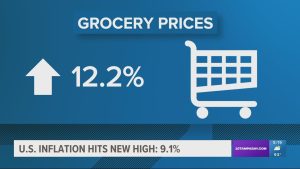U.S. inflation surged to a new four-decade high in June because of rising prices for gas, food and rent, squeezing household budgets and pressuring the Federal Reserve to raise interest rates aggressively — trends that raise the risk of a recession.
The government’s consumer price index soared 9.1% over the past year, the biggest yearly increase since 1981, with nearly half of the increase due to higher energy costs.
 Lower-income and Black and Hispanic American have been hit especially hard, since a disproportionate share of their income goes toward essentials such as transportation, housing and food. But with the cost of many goods and services rising faster than average incomes, a vast majority of Americans are feeling the pinch in their daily routines.
Lower-income and Black and Hispanic American have been hit especially hard, since a disproportionate share of their income goes toward essentials such as transportation, housing and food. But with the cost of many goods and services rising faster than average incomes, a vast majority of Americans are feeling the pinch in their daily routines.
For 72-year-old Marcia Freeman, who is retired and lives off of a pension, there is no escape from rising expenses.
“Everything goes up, including cheaper items like store brands,” said Freeman, who visited a food bank near Atlanta this week to try and gain control of her grocery costs. Grocery prices have jumped 12% in the past year, the steepest climb since 1979.
Accelerating inflation is a vexing problem for the Federal Reserve, too. The Fed is already engaged in the fastest series of interest rate hikes in three decades, which it hopes will cool inflation by tamping down borrowing and spending by consumers and businesses.
The U.S. economy shrank in the first three months of the year, and many analysts believe the trend continued in the second quarter.
“The Fed’s rate hikes are doing what they are supposed to do, which is kill off demand,” said Megan Greene, global chief economist at the Kroll Institute. “The trick is if they kill off too much and we get a recession.”
The likelihood of larger rate hikes this year pushed stock indexes lower in afternoon trading. The central bank is expected to raise its key short-term rate later this month by a hefty three-quarters of a point, as it did last month.
As consumers’ confidence in the economy declines, so have President Joe Biden’s approval ratings, posing a major political threat to Democrats in the November congressional elections. Forty percent of adults said in a June AP-NORC poll that they thought tackling inflation should be a top government priority this year, up from just 14% who said so in December.
After years of low prices, a swift rebound from the 2020 pandemic recession — combined with supply-chain snags — ignited inflation.
Consumers unleashed a wave of pent-up spending, spurred by vast federal aid, ultra-low borrowing costs and savings they had built up while hunkering down. As home-bound Americans spent heavily on furniture, appliances and exercise equipment, factories and shipping companies struggled to keep up and prices for goods soared. Russia’s war against Ukraine further magnified energy and food prices.
In recent months, as COVID fears have receded, consumer spending has gradually shifted away from goods and toward services. Yet rather than pulling down inflation by reducing goods prices, the cost of furniture, cars, and other items has kept rising, while restaurant costs, rents and other services are also getting more expensive.
The year-over-year leap in consumer prices last month followed an 8.6% annual jump in May. From May to June, prices rose 1.3%, following a 1% increase from April to May.
Fuelled by increase in the prices of oil, shelter and food, the inflation rate in the US rose to 9.1 per cent in June. The inflation rate rise was the largest 12-month increase since the period ending November 1981.
The US Bureau of Labour Statistics said: “Over the last 12 months, the all items index increased 9.1 percent before seasonal adjustment.”
“The Consumer Price Index for All Urban Consumers (CPI-U) increased 1.3 per cent in June on a seasonally adjusted basis after rising 1.0 per cent in May,” it said.
According to the Bureau, the increase was broad-based, with the indexes for gasoline, shelter, and food being the largest contributors.
The energy index rose 7.5 per cent over the month and contributed nearly half of the all items increase, with the gasoline index rising 11.2 per cent and the other major component indexes also rising.
The food index rose 1.0 percent in June, as did the food at home index.
The all items – less food and energy – index rose 5.9 per cent over the last 12 months. The energy index rose 41.6 percent over the last year, the largest 12-month increase since the period ending April 1980.
The food index increased 10.4 per cent for the 12-months ending June, the largest 12-month increase since the period ending February 1981. (IANS)
